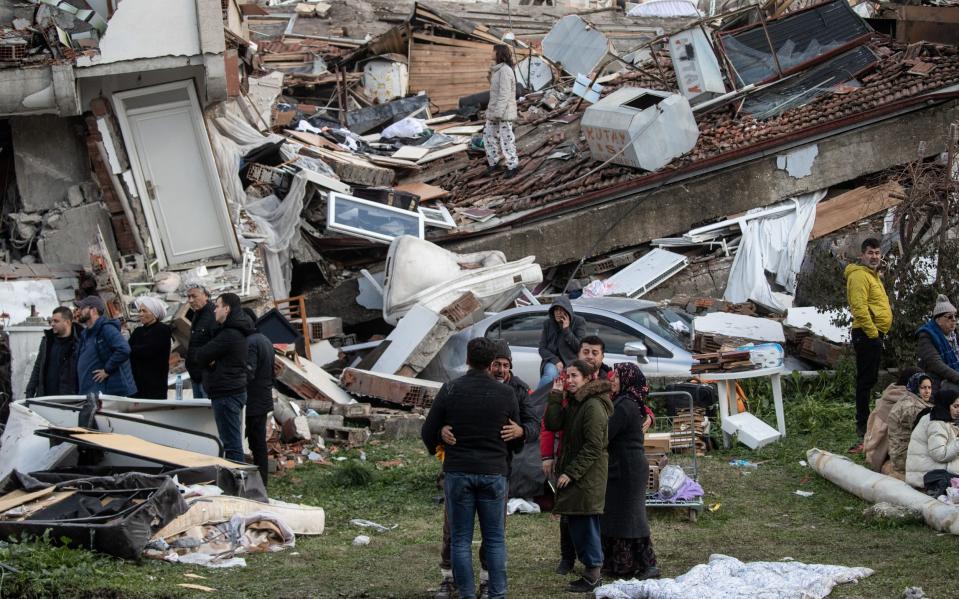Civilians risk life and limb to help free victims from Turkey earthquake rubble

Mehmet Can Yigitbas was buried in rubble for so long that his feet and lips turned blue.
Barefoot and dressed in house clothes, the freezing concrete slabs trapping him in his aunt’s collapsed apartment had sapped his strength by the time rescuers realised he was still alive on Monday morning.
He was trapped for so long that by the time rescuers finally reached him, his cousin Hakan Yigitbas had already reached the scene, having travelled all the way to Antakya from Istanbul.
So when Turkish soldiers finally dragged the pallid 32-year-old out on a stretcher, 36 hours after Monday’s earthquake destroyed it and most other buildings in this southern Turkish city, Mr Yigibas’ survival was still far from assured.
Fortunate, then, that his cousin – a professor of surgery – was on hand to oversee his treatment.
“He has crush injuries, as is to be expected,” said Dr Yigitbas, as paramedics applied a neck brace and administered fluids before the two cousins departed the scene together in an ambulance with sirens blaring.

If Mr Yigitbas was lucky to be rescued alive, many others in this southern Turkish city were less fortunate. The Telegraph saw at least eight dead bodies pulled from the rubble on Tuesday, a tiny fraction of a death toll that the World Health Organisation has warned could reach as high as 20,000.
However, despite emergency services being utterly overwhelmed by the devastation wrought by the 7.8 magnitude earthquake, the prospect of finding more people alive kept those on the job motivated as they entered a third night of uninterrupted rescue efforts.
Less than 100 metres from the building where Mr Yigitbas was recovered, just off Antakya’s main highway north, a motley group of volunteers worked frantically into Tuesday night, desperately attempting to reach a trapped 15-year-old girl entombed alive in a collapsed building, her legs pinned under rubble.
“We need a jackhammer! We need electricity!” a man shouted down from a precarious third-storey perch, as his colleagues attempted to wriggle deeper into the teetering structure.
Inside the building, the men used hammers, drills and an angle grinder powered by a generator, trying to open a route to the girl, who was trapped alongside her father and family.
With no heavy equipment, men outside heaved on a heavy strap in a vain bid to dislodge concrete slabs.

Standing amid a small crowd of onlookers, the girl’s uncle could only pray.
“All of my brother’s family is inside the building,” said Mehmet Aldic, 50.
But only his brother and his niece had made any noise, he said. It was unclear whether anyone else had survived the building’s collapse, or the ensuing two freezing nights.
“We just want to get everyone out alive,” he said. “This is just so important.”
A drive through his city on Tuesday showed that too many other residents remained in the same unenviable position.
In this city of 200,000 inhabitants set amid snowy hills a dozen miles from the coast and the Syrian border, nearly every building was damaged or destroyed. Some collapsed inwards, others fell against each other or tilted wildly into the street.
Residents counted themselves fortunate if they lived in a building where only one or two floors collapsed, or if a neighbouring building caught their own before it could fall. Improvised ladders and knotted sheets left dangling from balconies showed where lucky inhabitants had made their escape.
With Antakya’s airport closed and roads to ports and other southern Turkish cities damaged, emergency aid must travel a torturous route to reach the city centre.
Once emergency workers reopened the main highway north, volunteers began arriving in their thousands, with many flying into Adana, the nearest city with an open airport.
“Here is the biggest destruction in Turkey but the lowest priority and I don’t know why,” said Haroon, a 26-year-old Istanbul dentist who had volunteered to provide medical care but found himself standing by watching rescue efforts.
“There is nothing here I can do, but we will wait,” he said, vowing to stay on for at least a week.
But Haroon thought too many had remained in Adana taking too long to deploy elsewhere.
“In Adana, there were just 10 buildings down,” he said. “But at each of them, rescue was run by professional teams with diggers but no civilians.”
However, endless wailing sirens of emergency vehicles suggested that the provision of professional help was also being hindered by the thousands of eager but disorganised volunteers who travelled from across the country on roads already clogged with debris and the cars of local residents who were left sleeping in the streets.
While international rescue teams arrived by their thousands to Istanbul, Ankara and Adana airports on Tuesday, many thousands more Turkish volunteers donned fluorescent vests to contribute in whatever capacity they could.
“They told us ‘Just go’,” said Thabet, a Turkish Airlines worker who described being offloaded from a bus with no equipment and no orders after landing on a flight from Istanbul.
Even Afad, Turkey’s main disaster agency, was deploying people with no set mission, said one woman wearing an Afad ID badge and vest.
“I am volunteer, but I have no duty. I just look for some way to help,” she said, standing in a street of ruined apartment blocks. “Afad is so small for this big destruction.”
With professional rescuers overwhelmed, local residents undertook increasingly desperate measures to rescue trapped loved ones.
Ege, a business management student and alpinist from Istanbul, watched with concern as an earthmover tore into the rubble of a toppled building.
“They are picking sites randomly,” he said. “It’s not a safe way to do this. When you tell these people not to use bulldozers or cranes, they don’t listen.”

